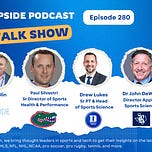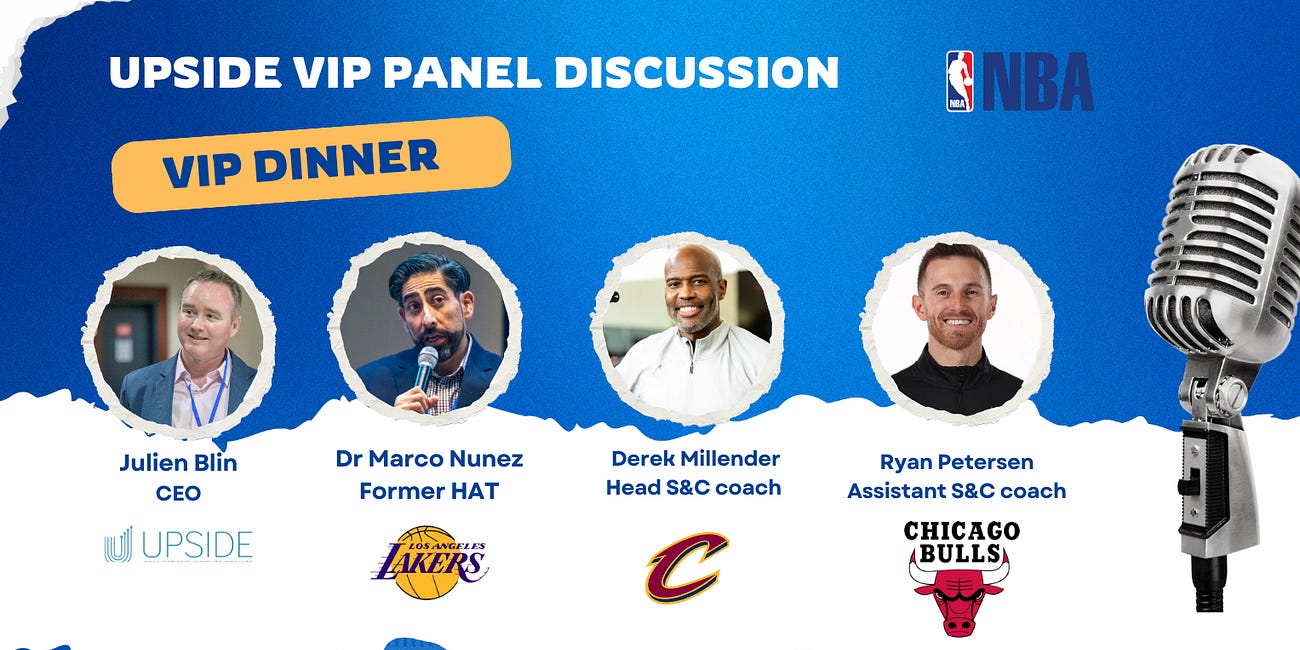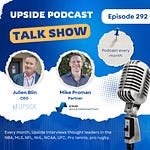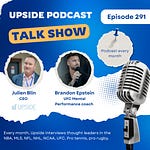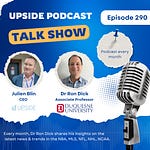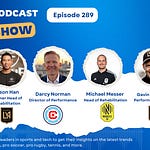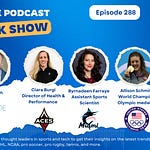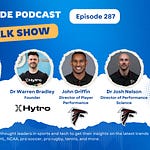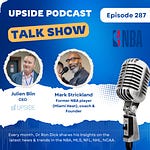This week we had the honor to interview a group of NCAA sports performance experts.
Dr. John DeWitt, Director of applied sports science in the athletic department and a faculty member, Rice University (NCAA team).
Paul Silvestri, Sr director of sports health and performance, University of Florida football (NCAA team).
Drew Lukes, Senior PT at Duke University and the head of sports science, Duke university’s women soccer team (NCAA team).
You can watch the video interview below by clicking on the Youtube link. You can also listen to the audio interview by clicking on the link at the top of the page:
📝Show Notes: Through this interview, we touched on:
Q1. Evaluating Technology Claims
With so many vendors making bold claims about performance gains, recovery benefits, or injury reduction, how do NCAA programs separate real value from marketing hype?
Q2. NIL & Athlete Opportunities
How is the NIL era reshaping the way student-athletes and universities think about recruiting, brand partnerships, and long-term athlete development?
Q3. Team Culture & Leadership
In today’s environment of constant change and external pressures, what strategies are most effective in building and sustaining a strong, values-driven team culture across NCAA programs?
Q4. Adversity & Resilience
What lessons have you seen athletes and teams learn from adversity—whether it’s injuries, setbacks, or off-field challenges—that can translate into both performance and life skills?
You can read the full transcript of the podcast interview located at the top of this blog post.
You can leave a comment by clicking on the button below:
Here are some of the best quotes of our conversation with them:
Q1. Evaluating Technology Claims
John DeWitt:
“One of the really cool things, but also one of the real problems today, is that technology vendors are being born weekly. A new tool is always coming out. That can be good, because data flows that used to take a long time are now accessible faster and more conveniently. But the real question is: what’s your current workflow, and what do you need that would actually help coaches and medical staff make better decisions? That’s where we separate value from hype. It doesn’t matter how cool something looks or how precise it claims to be—if it doesn’t fit into our workflow or slows us down, it’s not real value.”
“Improving workflow means either adding data we don’t already have, like nutrition, or making current processes faster. For example, motion capture in the lab is precise but takes hours and removes athletes from their natural environment. If a new system can give us kinematic data quickly, without slowing us down, that’s worth considering. If not, it’s hype.”
Paul Silvestri:
“On the recovery and injury side, I almost demand proof. If you’re making bold claims about speeding recovery or reducing injuries, I want to see the research. A lot of companies sprout up, make flashy claims, but lack any scientific backing. Some things we use are anecdotal or even placebo-driven, but when you’re talking about athlete health, you need evidence. Otherwise, you risk redundancy and data overload—‘paralysis by analysis.’ That’s where programs can lose sight of what’s important.”
Drew Lukes:
“For me, it starts with the end in mind. Does this technology solve a real problem we’re facing? If it doesn’t, then it doesn’t matter how impressive it looks. I also lean heavily on my network—people I trust who will tell me the truth, not the sales pitch. If they’ve tried it and can vouch for it, that’s worth more than marketing slides. And with schools like Florida or Duke, vendors are often eager to provide free trials just to have their product associated with our brand. That’s a great way to test if the tool actually delivers or if the claims fall flat.”
Q2. NIL & Athlete Opportunities
Paul Silvestri:
“The NIL era has completely reshaped the landscape. The first question recruits ask now is, ‘How much are you going to pay me?’ Years ago, they cared about facilities, staff, and development. Now, money is front and center. That changes recruiting, roster management, and long-term development. On the medical side, we carry a huge responsibility: if we’re investing NIL dollars, we can’t afford to overlook major red flags. With transfer athletes, we can review medical histories more easily, but with high school athletes it’s tougher. Still, we do our best to flag potential issues—like cartilage problems that could derail a career in short order.”
“It’s not just about injuries either. Character matters more than ever. If an athlete is solely motivated by money, it rarely works long-term. They’re more likely to transfer at the first sign of a better deal, or to sit out for minor injuries because they don’t want to risk their ‘investment.’ Coaches now have to evaluate: is this athlete bought into our program’s culture, or are they just chasing a paycheck? That’s the reality of NIL. And as programs add roles like general managers, this whole process is going to keep evolving.”
Q3. Team Culture & Leadership
Drew Lukes:
“Culture is a top-down process. It starts with the coaches casting a clear vision, but it also depends on the support staff being consistent. Athletes can’t hear one message from the coaching staff and another from medical or performance. Consistency is critical. For us, culture is also about boundaries—letting student-athletes know what’s expected and holding them accountable. That can be challenging in an athlete-driven NCAA environment, but without consistency, culture falls apart.”
John DeWitt:
“I don’t define culture by winning or losing. If you say your culture is winning, then one loss means your culture is broken. True culture is about excellence. Excellence is controllable—how we prepare, how we treat people, how we work daily. Winning is the outcome of excellence, not the definition of it. If you focus culture on excellence, it sustains you through both victories and losses.”
Paul Silvestri:
“The foundation of culture is having the right people in the room. If athletes only care about money, they won’t buy into the culture. They’ll transfer at the first chance. But when you recruit people who align with your values, culture is what keeps programs strong, even with all the external pressures of NIL and constant change.”
Q4. Adversity & Resilience
Paul Silvestri:
“I tell athletes all the time: in a split second, you can go from feeling 100 percent to having your season lost. Don’t ever forget that feeling. When you’re out with an ACL or another long-term injury, use that pain, that hunger, to fuel your return. Adversity makes you stronger if you embrace it. But if you go into a shell, you lose the lesson. We hammer that into our athletes—don’t take being on the field for granted, because in a heartbeat it can be gone.”
“Even for us as staff, adversity is real. When the team isn’t winning, it’s easy to get discouraged. But I remind my staff: our job doesn’t change when the scoreboard isn’t in our favor. We still have to show up, provide the best care, and be the positive voice in the building. It’s harder during losing streaks, but that’s when it matters most.”
John DeWitt:
“Resilience isn’t fixed—it’s learned. Athletes don’t come pre-packaged with grit; they develop it through setbacks. We have to help them see that failure is where growth happens. I’ve worked with NASA astronauts who trained thousands of hours, making countless mistakes, just for a three-hour spacewalk. That’s the mindset athletes need: failure in training is preparation, not a reflection of your ability. Resilience comes from practice, from falling short and learning, not from avoiding failure.”
“For me, culture is consistency. I don’t change my approach whether we’re winning or losing. Culture is about how we operate every day, not about the scoreboard. If you’re Real Madrid and you define culture as ‘winning,’ every single loss feels catastrophic. But if your culture is excellence, then you don’t lose it when results go against you—you sustain it, and that helps you bounce back.”
Drew Lukes:
“Rehab is one of the hardest adversities a young athlete will face. These are 18- to 20-year-old kids, and for many, it’s the toughest thing they’ve ever gone through. My job is to give them perspective. I’ll tell them: take a snapshot on day three after surgery when you can’t even lift your leg. Six months later, when you’re frustrated you can’t score in practice, look back at that moment. Rehab is brutal, but it’s also a trial by fire. The athletes who embrace it come back stronger, hungrier, and often become the most inspiring leaders on the field.”
You may also like:
🔥Upside NCAA Group Chat with Eric Renaghan (University of Miami/NCAA), Drew Lukes (Duke University/NCAA), Dr John DeWitt (Rice University) On The Transfer Portal, NIL, AMS, Nutrition And More
This week we had the honor to interview a group of NCAA sports performance experts.
🔥Upside NBA Video Chat with Dr Marco Nunez (Ex LA Lakers/NBA), Derek Millender (Cavs/NBA), Ryan Petersen (Chicago Bulls / NBA) on The Life after the NBA, Technology Adoption, Performance Optimization
This week we have the honor to interview again a group of NBA sports performance executives to talk about the latest trends in the world of sports performance and rehabilitation.

